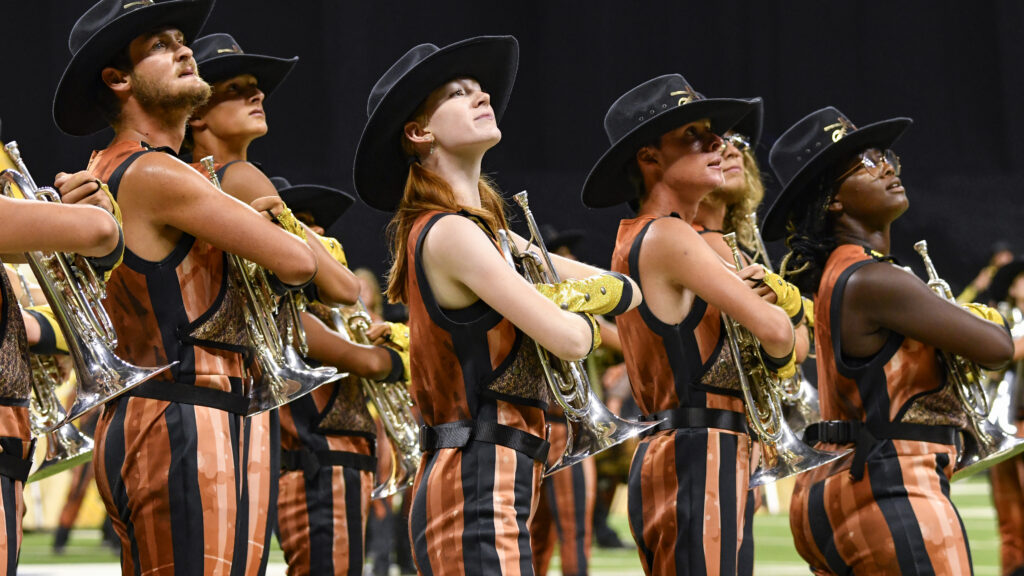The Blue Devils set a record when the undefeated corps scored 99.650 at the 2014 Drum Corps International World Championship Finals, shattering the previous high mark jointly held by the 2002 Cavaliers and 2005 Cadets.
The Devils’ “Felliniesque” captured perfect scores from all four general effect judges and all three visual judges, helping the corps win every caption except percussion, which went to the fourth-place Santa Clara Vanguard.
Finishing between those two corps were the second-place Bluecoats and third-place Cadets, the latter corps slipping into the Finals competition after taking 2nd in both Prelims and Semifinals. With the corps’ popular “Tilt” production, Bluecoats most memorably introduced the term “pitch bend” to the vocabularies of fans.
Revisiting the corps’ “Attraction: The Music of Scheherazade” show of 10 years earlier, Santa Clara Vanguard again explored the music of Russian composer Nikolai Rimsky-Korsakov with “Scheherazade: Words 2 Live By,” based on the collection of Arabic folk tales by numerous authors collectively known as “One Thousand and One Nights.” According to corps staff, the show picked up where the 2004 production left off, the numeral “2” in the title referred to the corps playing the music for the second time.
Rimsky-Korsakov, one of Russia’s most prominent and popular composers, is recognized for several works that have appeared in the shows of DCI finalists. He created “Scheherazade” in 1888, naming the piece after the main character in “One Thousand and One Nights,” a sultan devastated to learn his wife had been unfaithful.
Setting the theme, Vanguard set across the back of the field an Arabian skyline, with iconic pointed mosque domes and slender minaret towers. In front of several color guard members sat the sultan, wearing royal regalia, with the Scheherazade character sitting on his lap, a large open book indicating she would soon share some stories.

A short front ensemble introduction led to 24 trombones blaring out the opening theme of the sultan’s intimidating supremacy, each of the trombonists standing atop three stacked pillows found in the sultan’s harem. The creative staff considered these opening moments to be a re-introduction of the story from 10 years earlier. Curlicue flags of ornamental brocade enhanced the sense of royal extravagance.
Brass players marched into a cresting form of moving waves, suggesting the story of Sinbad the Explorer, one of the best-known recollections in “One Thousand and One Nights,” and also harkening back to the peaks of ocean waves that traversed the field in the 2004 production. Accompanied by solid gold flags of the sultan’s riches, the horns formed an unmistakable “2,” as intricately laced drill formations picked up on the curlicue designs of the earlier flags.
A book marked “Aladdin” introduced Vanguard’s ballad movement inspired by the story of Aladdin’s lamp, the source of much wonder when rubbed to summon the genie. Accompanied by rustling wind sounds, the sultan pulled out a flowing white silk from the book, releasing the magic of the genie’s powers. The large pillows were brought out to the field in a giant arc as female color guard members gently waved large feathered fans, the remainder of the guard wearing flowing skirts the same colors of deep purple and light blue that were utilized as capes.
The story, “Ali Baba and the 40 Thieves,” introduced by a performer bearing a scimitar, inspired the third segment of the show. Not meant to be a literal retelling of the story, it was built around the hubbub of an Arabian bazaar. The horn line formed another “2” that evolved out of the sequential formation of the same horns passing through an “S,” “C,” and “V” in quick succession.
Twenty-four brass players appearing to row a boat foreshadowed the show’s fourth section, that of Sinbad, with blue flags of ocean waves. An advancing company front disintegrated into left-to-right sequentially mirrored forms that spelled “SCV 1,” introducing new flags of ornate curlicues.
The trombones returned to pump up the volume prior to the quiet ending, as Scheherazade, free from the fear of being killed by the sultan, symbolically closed the book on the end of the story after popping up through a large parachute-like fabric that swallowed up all the horns and the color guard.

Michael Boo was a member of the Cavaliers from 1975-1977. He has written about the drum corps activity for more than 35 years and serves as a staff writer for various Drum Corps International projects. Boo has written for numerous other publications and has published an honors-winning book on the history of figure skating. As an accomplished composer, Boo holds a bachelor's degree in music education and a master's degree in music theory and composition. He resides in Chesterton, Indiana.





